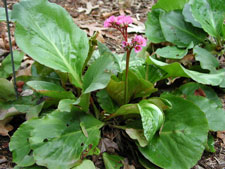Resource Library
Plant of the Week: Heartleaf Bergenia
The University of Arkansas System Division of Agriculture does not promote, support or recommend plants featured in "Plant of the Week." Please consult your local Extension office for plants suitable for your region.
Plant of the Week
Heartleaf Bergenia
Latin: Bergenia cordifolia

Wishful thinking hits all of us at one time or another. Gardeners, especially, if they have a serious case of plant-lust, are often seriously afflicted with it and try growing plants not likely to thrive in their area.
Occasionally, as with heartleaf bergenia (Bergenia cordifolia), we find we can grow it but it never looks as good as it does further north.
Bergenia is an evergreen herbaceous perennial of the saxifrage family that comes to us from the Altai Mountains of Mongolia and adjacent areas of Siberia, so at its heart it is a cold weather plant. There are 10 species of bergenia described in the Flora of China, where most of the species are found.
This species is 12 inches to 16 inches tall when in flower with large, leathery, heart shaped leaves to 10 inches long produced from a slowly spreading underground rhizome. Plants are clump forming and usually about a foot wide. In the winter, leaves turn maroon-purple. In cold, exposed areas the foliage may winterburn and be tattered come spring.
In mid-spring bergenia sends up a foot-long inflorescence of pink flowers in an open cyme. Individual flowers have five petals and are about the size of a dime. Flowers are a bonus; the main impact of bergenia is its evergreen foliage.
The first bergenia, B. crassifolia, was sent to Linnaeus by David De Gorter, the doctor for the Elizabeth Petrovna who was Empress of Russia from 1709 - 1762. B. cordifolia was collected in Siberia in 1779. The new Flora of China now lists these two species as synonyms with B. crassifolia having precedence.
Over the years, botanists have not known where to classify these plants.
The genus name honors Professor Karl A. von Bergen (1704-1760), a professor of botany at Frankfurt, Germany, and was given by Conrad Moench (1744 - 1805), a German botanist who published the name in his Methodus Plantas in 1794. Linnaeus had classified it as a species of Saxifrage; Moench renamed them Bergenia;others reclassified them as species of Megasea (still sometimes used as a common name in Europe), then back to Saxifraga, and finally back to the Bergenia after the 1950s.
Most of the bergenias now sold are probably hybrids. During the early years of the 20th century, several English and German breeders developed a number of hybrids. Today, breeding efforts based on some of the less-cold hard species are intensifying and newly named introductions are becoming increasingly common.
Bergenias, like most members of the Saxifrage family, do best in areas with uniformly moist soil and bright light but not direct sun. In their native haunts they often grow on steep mountain slopes in rocky crags where drainage is good but the roots never want for water.
In the garden, they’re best located in areas with rich, water-retentive soil that is well amended with organic matter. In northern areas, bergenias can be grown where they receive sun but in the south they must have shade. The north side of a house or anywhere in the shade garden is the best bet.
They’re listed as hardy from zone 3 to 8 but are really at their best in zones 4 to 6. In warmer parts of the region, they should be situated in the coolest parts of the garden, and they should be watered carefully during periods of heat and humidity.
In areas where well-adapted, this is one of the best evergreen groundcovers even though it’s relatively uncommon. Its bold wintertime foliage makes a nice foil during the winter months. Snow cover during winter is especially beneficial. It’s also well suited for use in woodland rock gardens where it can provide an evergreen foil in the winter months.
By: Gerald Klingaman, retired
Extension Horticulturist - Ornamentals
Extension News - March 21, 2008
The University of Arkansas System Division of Agriculture does not maintain lists of retail outlets where these plants can be purchased. Please check your local nursery or other retail outlets to ask about the availability of these plants for your growing area.